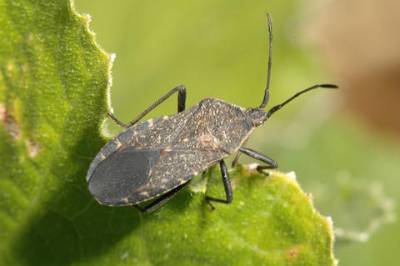Squash Bugs

These pests overwinter as adults and are becoming active now looking for mates and host plants. Once mated the females will start laying eggs from June till mid-August. Adult squash bugs are somewhat flattened and 1/2 to 3/4 of an inch long. As an adult, squash bugs are dark-brown and have wings with brown-to-black and orange markings along the outer edge of the body. Nymphs will start out light colored but with each successive molt will gradually get darker in color. Squash bugs feed on the leaves, vines and fruits of squash, pumpkins and other cucurbits using piercing-sucking mouth parts to remove fluid from the plants. Younger, small plants are more susceptible to damage than older plants, however if the numbers get high enough they can kill any size of plant.
The first step to management is to scout, starting in June for all stages of squash bugs on your plants. For small plantings you can use floating row covers to exclude the squash bugs, but you will have to remove the covers to allow bees to pollinate the flowers. For small infestations, or again a few plants, try to pick the bugs off by hand and destroy the insects. This would need to be done every 3-5 days depending on the number of squash bugs you have. You can also place boards on the ground underneath the plants to provide an area for the insects to gather which can make it easier to kill them as needed.
Use “trap plants” on the outside of the garden to catch the mother squash bugs before they reach the main patch. You can then use insecticides or remove those plants once eggs are laid but before they hatch. There are some parasitoid wasps that will attack and kill squash bugs. The tachid fly and Gryon pennsylvanicum are two parasitoids that will feed on squash bugs.
Insecticides are a common method of treatment to kill squash bugs. Horticultural oils can be used to smother eggs before they hatch and during young nymph stages. Products containing Carbaryl (Sevin) or Permethrin can be effective at controlling squash bugs when they are young. As the bugs get older they get harder to kill as they develop a waxy cuticle that protects them from chemicals. With any chemical application be sure to get the underside of the leaves and try to apply it early in the morning or late in the evening to be less harmful to pollinators. In the fall, be sure to remove all debris and discard from the area to prevent the squash bug adults from overwintering in your garden. Try to mow the grass around the garden and reduce vegetation to reduce the insect population in your area.

Have questions? Contact our office where our Horticulture Extension Agent will assist you with questions.
Phone: (316) 321-9660
Email: callae@ksu.edu